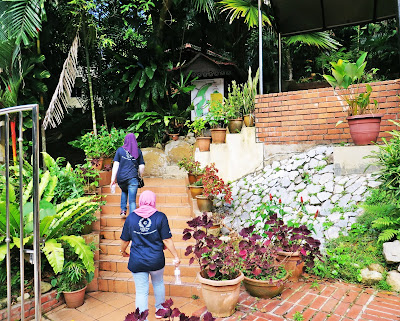Pocket jungle in the city
December 13, 2018
 |
| Entrance to Information Centre and Interactive Gallery in Jalan Raja Chulan |
While many
cities in the world boast of having huge parks, it is rare to find a forest
reserve in a city centre and folks in Kuala Lumpur can be proud that their city
is home to one of the oldest tropical
rainforest reserves in Malaysia.
The KL Forest Eco-Park, located near the
KL Tower, is the last stretch of permanent forest in the city. Sadly, most
residents (myself included) have not found the time to appreciate this ancient
green lung has to offer. On a recent Saturday morning, I found myself amongst a
group of writers at the Jalan Raja Chulan entrance, waiting for the guide to
take us on one of its many walking trails.
Of the original gazetted
land area of 17.5 hectares (KL Tower stands on part of the land), the Forest
Eco-Park has been reduced to only 9.3 hectares but some of the trees here are
several hundred years old. It used to be known as Bukit Nanas (Pineapple Hill) Forest
Reserve, as pineapples used to be grown around its perimeter. The hill (94m
above sea level) also served as a main tin storage compound in the 1820s.
 |
| Inside the Information Centre and Interactive Gallery |
Pineapples used to be planted around the hill as defence strategy by a Malay leader named Raja Asal. According to Heritage Malaysia (www.heritagemalaysia.my): “It is said that in 1871,
Bukit Nanas, which at the time was not known by this name, was made a fortress
by Raja Asal. To stop his enemies from entering his fortress, Raja Asal planted
pineapples around the hill.
"In those days it was normal for people to go about
barefooted and the spikes of the pineapple plant served as an effective
obstruction." Unfortunately, it didn't work and Yap Ah
Loy's followers, with the aid of Tengku Kudin and the British in Selangor, managed to infiltrate the "pineapple fortress".
For more information about the park, the Information
Centre at the Jalan Raja Chulan entrance has a small exhibition area and Interactive Gallery comprising photographs and graphic illustrations of
wildlife.
We learnt that the Forest Eco-Park is home to snakes, two species of monkeys, squirrels and 25 species of birds including white rumped shama and scarlet breasted flowerpecker. The guide said that if we were lucky, we might even catch sight of monkeys or a raccoon or two. Unfortunately, we didn’t.
We learnt that the Forest Eco-Park is home to snakes, two species of monkeys, squirrels and 25 species of birds including white rumped shama and scarlet breasted flowerpecker. The guide said that if we were lucky, we might even catch sight of monkeys or a raccoon or two. Unfortunately, we didn’t.
 |
| Glorious yellow Hibiscus flower |
As we walked, he pointed
out various trees such as camphor, jelutong, karas, kapur, palms and bamboo as
well as the giant liana vine (imagine Tarzan swinging through the forest and holding on to these) and herbs of interest, including two species of the infamous Tongkat Ali (Eurycoma longifolia), a root herb taken to boost male virility.
A huge attraction of
the Forest Eco-Park is a 200m canopy walk that offers a splendid aerial view of
the city beyond the tree tops. At the fence separating the forest from KL Tower, we watched playful
raccoons at the Tower’s mini zoo compound.
 |
| Take a walk among the tree tops |
 |
| Even children enjoy the canopy walk. Right: Stairs leading to the top |
KL Forest Eco-Park may be accessed from various entrances, such as via Jalan Raja Chulan, Jalan Ampang, Jalan Bukit Nanas or from KL Tower.
KL Forest Eco-Park
Where:
Bukit Nanas
Jalan Raja Chulan
Kuala Lumpur
Jalan Raja Chulan
Kuala Lumpur
Opening
Hours:
Daily,
8am to 6pm
Tel: +603-2070
6342





No comments:
Post a Comment